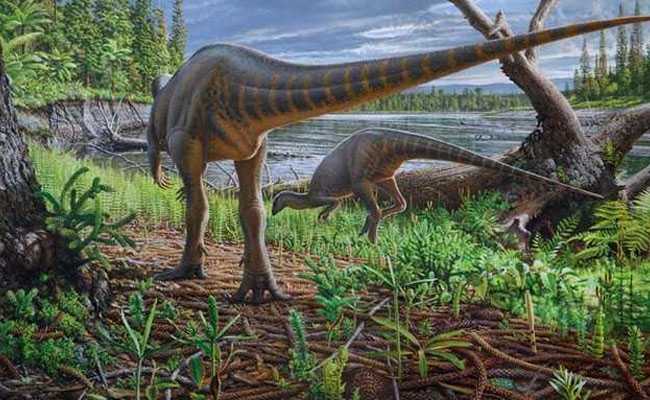
London: Footprints from at least six different species of dinosaur – the very last dinosaurs to walk on UK soil 110 million years ago – have been found in Kent, a new report by researchers has claimed.
The discovery of dinosaur footprints by a curator from Hastings Museum and Art Gallery and a scientist from the University of Portsmouth is the last record of dinosaurs in Britain.
The footprints were discovered in the cliffs and on the foreshore in Folkestone, Kent, where stormy conditions affect the cliff and coastal waters, and are constantly revealing new fossils.
“This is the first time dinosaur footprints have been found in strata known as the ‘Folkestone Formation’ and it’s quite an extraordinary discovery because these dinosaurs would have been the last to roam in this country before becoming extinct,” said David Martill, Professor of Palaeobiology, at the University of Portsmouth.
“They were walking around close to where the White Cliffs of Dover are now – next time you’re on a ferry and you see those magnificent cliffs just imagine that,” he said.
The findings have been published in the journal ‘Proceedings of the Geologists’ Association’ this week and some of the footprints are on display at Folkestone Museum.
The footprint fossils formed by sediment filling the impression left behind when a dinosaur’s foot pushes into the ground, which then preserves it.
The footprints are from a variety of dinosaurs, which shows there was a relatively high diversity of dinosaurs in southern England at the end of the Early Cretaceous period, 110 million years ago.
They are thought to be from ankylosaurs, rugged-looking armoured dinosaurs which were like living tanks; theropods, three-toed flesh-eating dinosaurs like the Tyrannosaurus rex; and ornithopods, plant-eating ‘bird-hipped’ dinosaurs so-called because of their pelvic structure being a little bit similar to birds.
Philip Hadland, Collections and Engagement Curator, at the Hastings Museum and Art Gallery is lead author on the paper.
“Back in 2011, I came across unusual impressions in the rock formation at Folkestone. They seemed to be repeating and all I could think was they might be footprints,” said Hadland.
“This was at odds with what most geologists say about the rocks here, but I went looking for more footprints and as the tides revealed more by erosion, I found even better ones. More work was needed to convince the scientific community of their validity, so I teamed up with experts at the University of Portsmouth to verify what I’d found,” he said.
Most of the findings are isolated footprints, but one discovery comprises six footprints – making a “trackway”, which is more than one consecutive print from the same animal.
This trackway of prints are similar in size to an elephant footprint and have been identified as likely to be an Ornithopodichnus, of which similar, but smaller-sized footprints have also been found in China from the same time period.
The largest footprint found – measuring 80 cm in width and 65 cm in length – has been identified as belonging to an Iguanodon-like dinosaur.
Iguanodons were also plant-eaters, grew up to 10 metres long and walked on both two legs or on all fours.
(This story has not been edited by NDTV staff and is auto-generated from a syndicated feed.)








